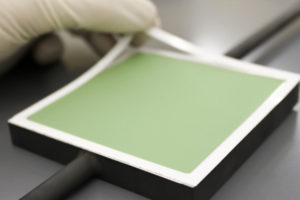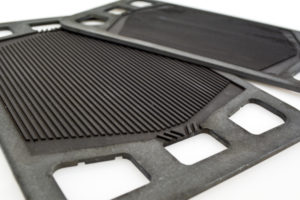Anode or Electrolyte supported, that is the question. There are multiple types of Solid Oxide Fuel Cells (SOFCs), which are defined by the support material. The support is the thickest portion of the cell design and is the backbone that provides the mechanical strength. Thus, all of the various layers of a SOFC are potential supports – cathode, anode and electrolyte layers have all been used as support structures. Currently, the most common types of cells are anode and electrolyte supported. These two are favored over cathode supported cells due to conflicting material processing temperatures required during manufacturing. A dense zirconia electrolyte membrane typically requires a minimum sintering temperature of 1300 °C, which is higher than the temperature where zirconia reacts with common cathode materials. Therefore, to choose between anode and electrolyte supported cells, it is best to consider the pros and cons for each approach which are described below:
Anode Supported Cells
Cells built with anode as the support structure have the advantage of having a thin electrolyte membrane. This greatly reduces the ohmic loss attributed to the electrolyte thickness, which enables lower operating temperature and higher performance. The lower operating temperature greatly reduces degradation (related to the corrosion of the ancillary reactant delivery equipment and adverse effects on the cell), thereby increasing lifetime. Additionally, this design has a thin cathode layer that provides an opportunity for tailoring the cathode material formulation to enhance performance or provide chemical resistance for various applications. A downside to anode supported cells is that the nickel cermet support must be porous to allow for gas diffusion; thus, it is harder to seal the periphery. In addition, the diffusion resistance of the anode gases through this thick anode support structure makes it difficult to achieve high single pass fuel utilization.
Electrolyte Supported Cells
In contrast to the anode supported, electrolyte supported cells have the advantage of having a dense electrolyte membrane and thin anode and cathode electrodes. The dense electrolyte membrane enables enhanced sealing at the periphery of the cell, reducing efficiency losses due to reactant leakage. A thin anode electrode greatly reduces diffusion resistance. This in conjunction with enhanced sealing enables high single pass fuel utilization to be achieved. Additionally, because this design has thin anode and cathode layers it provides the opportunity for optimizing both material for various applications. Thus, enhanced performance or chemically resistant anode and cathode formulations can be developed. The downside to this approach is the thick electrolyte increases ohmic losses; thus lowering power density. Therefore, this cell type requires higher operating temperature to achieve equivalent performance.
Making The Choice
Ultimately, the choice should be made based on the requirements for your application/development focus. Anode supported cells allow for a lower operating temperature which is beneficial for long-term degradation studies. Electrolyte supported cells are great for studying the effect of high fuel utilization and developing tailored anodes to increase performance and chemical resistance to various poisons (sulfur, arsenic, etc.). Both cell types provide the opportunity to develop cathode formulations. Whatever your application or development focus, Fuel Cell Materials has the cell technology to support your needs.





